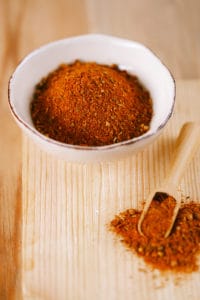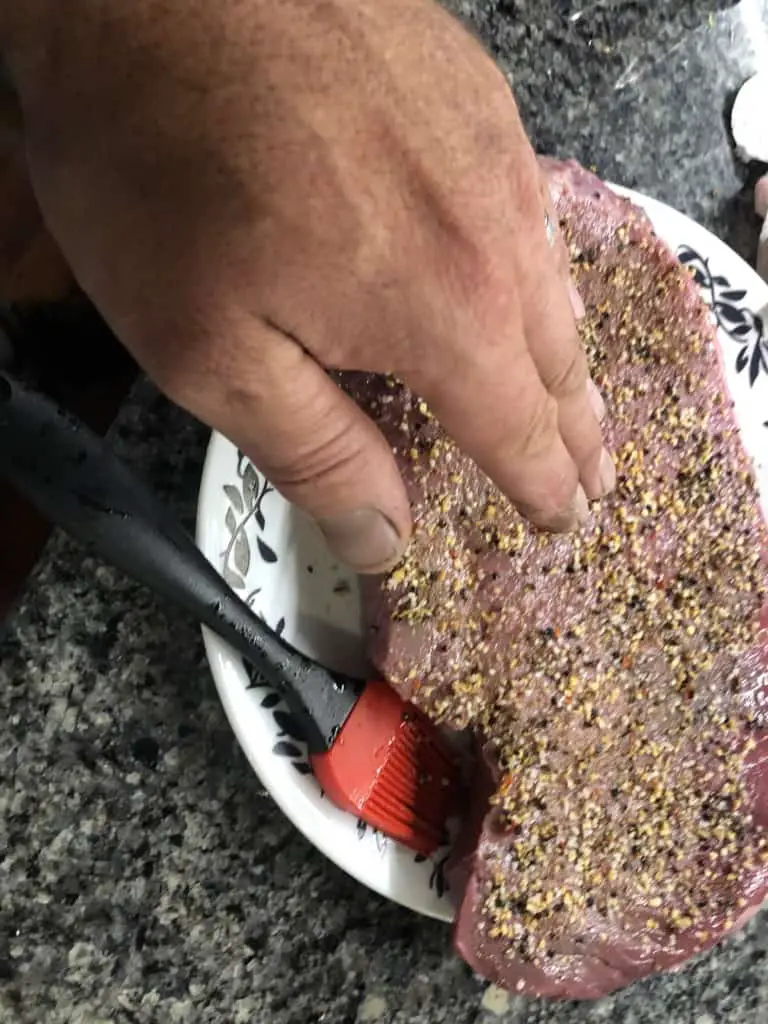
You’ve decided you want to try to get more flavor into your food and remember reading somewhere about using a dry rub to make your food more flavorful. Now the question is what exactly is a dry rub and how do you add it to your food.
What Does Dry Rub Mean? A dry rub is a mixture of spices most commonly combined with sugar and sea salt. This mixture can be rubbed directly onto raw meats and left to sit for a period of time before cooking. It will add the flavor of the spices to the meat. You may have also heard this called a spice rub.
A big advantage of using a dry rub is that you can decide to do it on short notice. Or for that matter no notice if you decide you just don’t want plain chicken tonight – you can go ahead and put a rub on and get to cooking.
Don’t get me wrong if you decide the night before that you wanted to try a new dry rub, go ahead and put it on the meat right away. The longer it sits the more flavor penetrates into your food. Just be careful on some thinner cuts of meat. A rub can pull too much moisture out and completely ruin the cut of meat.
When To Use A Rub
There’s really no wrong time to use a dry rub. It really all depends on your mood and the amount of flavor you’re looking for in your meat.
Using a dry rub on something like steak can not only help to spice things up but can also bring out the natural flavor of the meat. Applying it 20 to 30 minutes before will allow the salt to penetrate the meat and start to tenderize the steak for you.
If using it on something like chicken, you can get a great barbecue flavor without cooking it on the grill. Much like using a rub on a steak, it’s going to start to break down the muscle fibers and tenderize the meat as well as add flavor. It depends on the rub, but you should apply it at least 15 minutes prior to cooking.
How To Make A Dry Rub
You’re going to want to use spices that work together obviously. But it’s all about developing flavors you’re going to enjoy and that will complement the meat you’re going to add them to.
Some people add other ingredients like herbs and garlic to their rub mixtures. The mixture is going to all be based upon the type of flavor you are going for in your food.
Your most basic dry rub is going to be made from coarsely ground black pepper, sugar, and sea salts. If you use brown sugar in your rub it’s going to give you a nice caramelized coating on your meat. But that’s just the basics of a dry rub. If you like heat you can add cayenne pepper; if you like garlic add garlic. Really there’s not a wrong way to make a dry rub.
A benefit of using a dry rub is it’s going to create a crust of spices on the food. This means every bite is going to be packed with flavor.
The biggest advantage of the dry rub is that it doesn’t add extra moisture to your food. When you add extra moisture it has to evaporate for the meat to get a good sear on it. But due to the nature of dry rubs: they are – well dry. You don’t have any issues with added moisture and a sear can start almost immediately.
What Are Dried Spices
When it comes to cooking and somebody says dry spice, they are referring to any part of a plant other than the leaves that have been dried and are being used for seasoning or flavoring in a recipe but not as the main ingredient. So they’re referring to the part of the plant like dried bark, roots, seeds, berries, twigs: pretty much everything but the leaves of the plant.
So why not the leaves? Simply put when it comes to the leaves or any leafy green part of a plant that has been dried and is being used in this matter, they’re reclassified as herbs instead of spices.
As an example, if you were to use something like dill weed which is a leaf, you’re using an herb. But if you do use dill seeds then it’s a spice. Even though they both came from the same plant and will give you a similar flavor, they have two different classifications.
Some examples of spices that you’ll commonly find in a dry rub are:
- Chili powder is made from a variety of dried pulverized chili peppers and will add pungency or piquancy flavor to your dish.
- Cumin is a highly versatile spice commonly used in conjunction with chili powder that is known for being called rich and healthy, warm and earthy.
- Onion powder is going to add a zestiness and sweetness to any seasoning blend. But can be easily overused in your rub mix. Try not to use too much
- Black pepper – next to salt this is the most commonly used spice in the world. Pepper adds both heat and depth of flavor to any dish while enhancing other flavors.
- Turmeric is not a commonly used spice. It has a strong earthy flavor more common in Middle Eastern cuisine but works well with chicken.
- Kosher Salt is the most basic of seasonings but also the most critical. It’s great for enhancing the flavors of your food but it has to be used carefully or you can over salt and your food just tastes like salt. It’s best to use during the cooking process and not afterward.
How to Apply Dry Rubs
Before applying a dry rub it’s always a good idea to rinse off the meat. At the very least wipe it down with some paper towels. This is done to remove any surface contaminants left over from the packaging and processing process. If you rinse it off make sure to dry it with some paper towels after.

Now you could just go ahead and add your rub mixture on top of the meat and rub it in with your hands. But a lot of people recommend adding something on top of the meat to make the rub stick to it. Most commonly people are going to use either olive oil or mustard. It’s up to you which one you like to use. I do prefer to use mustard. It will add a little bit of mustard flavor into the meat as well.
Now that you’ve gotten your dry rub on the meat use the palm of your hands or your knuckles aggressively to press it into the meat. You are trying to press some of the salt and spices just below the surface of the meat to help start tenderizing it.
Now if you’re applying a dry rub to chicken with the skin on, most cooks will tell you to separate the skin from the chicken and place the dry rub between the skin and the chicken. But I don’t mean remove the skin completely. Just make it a pocket you could pour dry rub in and use your hand to spread it underneath the skin.
How Long Should You Leave a Dry Rub-On
How long you leave your dry rub on is all going to depend on the depth of flavor you’re trying to achieve in your food and the amount of time you have available before you need to cook the food. You can do anything from 24 hours (but nobody wants to push dinner back until tomorrow night), or you can just do 15 minutes. Either way, you going to have added flavor into your meat.
Now if you didn’t decide to do a dry rub at the last minute and you do have some time, I would recommend on your red meats letting it sit for 4 to 8 hours to allow the flavors to penetrate into the meat. You’re going to want to keep it in the refrigerator during that time. There’s some debate on if you should cover it with plastic wrap or not. I’ve always used plastic wrap and have never had a problem. Please don’t let it sit on your kitchen countertop for that long.
For thinner cuts of meat like fish and chicken fillets you really don’t want to leave the dry rub sit on it for too long. It’s going to pull the moisture out of the meat, and if it’s left too long, it could end up ruining the cut of meat. So those only really need a half-hour to an hour. Again I would wrap it in plastic, but definitely put it in your refrigerator.
What’s The Difference Between Dry Rubs And Marinades
So I think we’ve covered dry rubs pretty well in the above article, so you already know that a dry rub is composed of all dry ingredients – hence the name dry rub. So the real question here is what is a marinade.
A marinade may contain the same dry ingredients as your dry rub but will have an acidic liquid added to it like vinegar, citrus or wine. This is going to help speed up tenderizing your meat why it’s resting.
Much like your dry rubs, a marinade on a thicker cut of meat can be left to rest for 12 to 24 hours if you have the available time to do so. If not, 30 minutes or so will be fine as well. Much like dry rubs on your thin cuts of meat, you really don’t want to go more than one or two hours.
Can you Turn a Dry Rub Into a Marinade
Yes, you can definitely turn a dry rub into a marinade since they use essentially all the same dry ingredients. All you would really have to do is add some kind of acidic liquid or enzyme to it. That’s going to allow the meat to soak in it and help with tenderizing it.
Some things you can try are lemon juice or wine for your acidic liquid. For enzymes, you might want to try something like mango or kiwi juice and give yourself a more exotic flavor. I’ve even seen pre-packaged rubs in the store that say you can add beer to them to make a marinade.
As always, happy grilling!

Rufus Teague: Dry Rub
Award Winning Premium Rubs for Meats & Veggies – Masterful Blends of Herbs and Spices – Elevates Your Meals – Natural Ingredients – Gluten-Free & Kosher

Rubs: 2nd Edition
Over 150 recipes for the perfect sauces, marinades, seasonings, bastes, butters and glazes (The Art of Entertaining)
